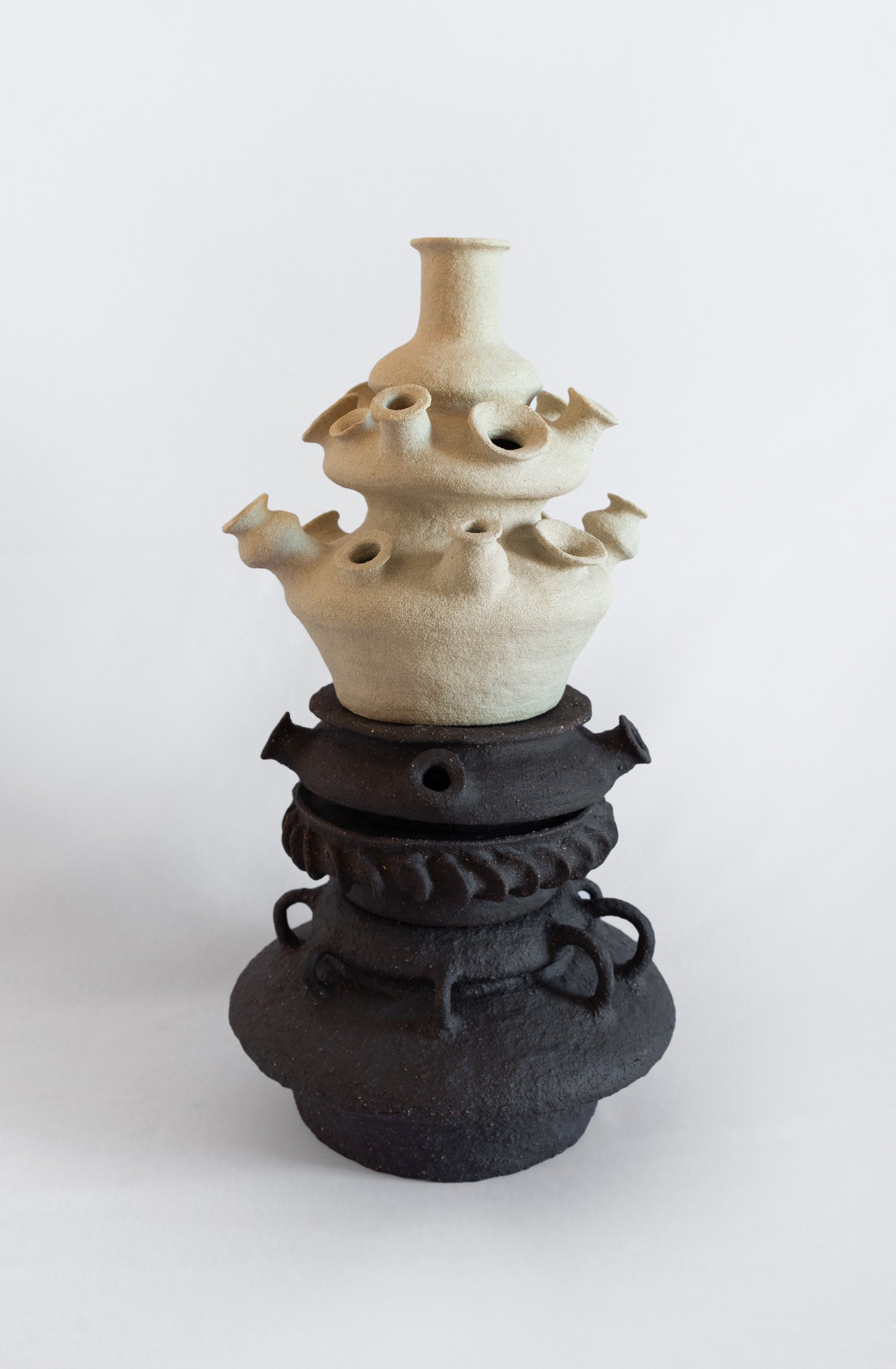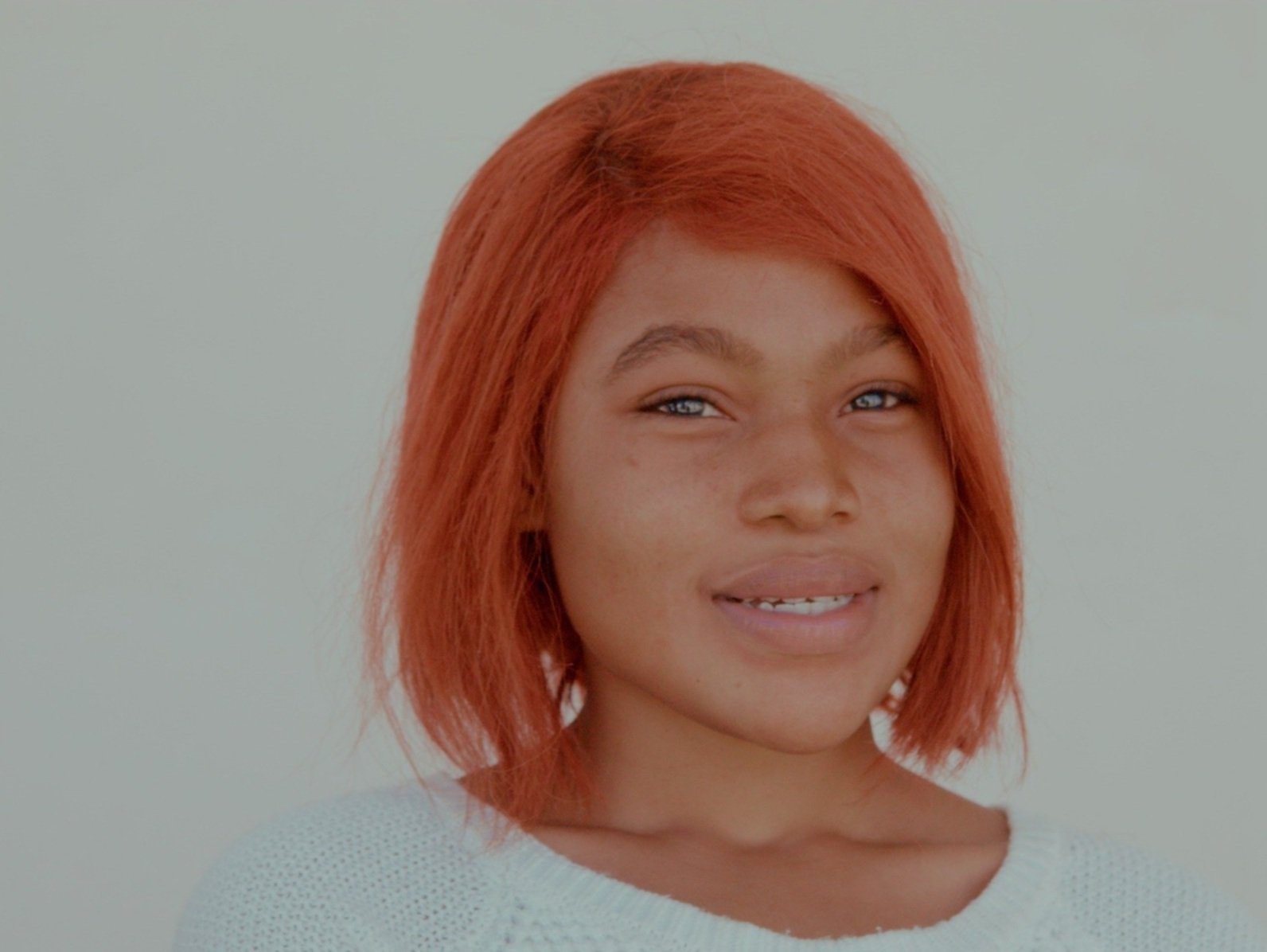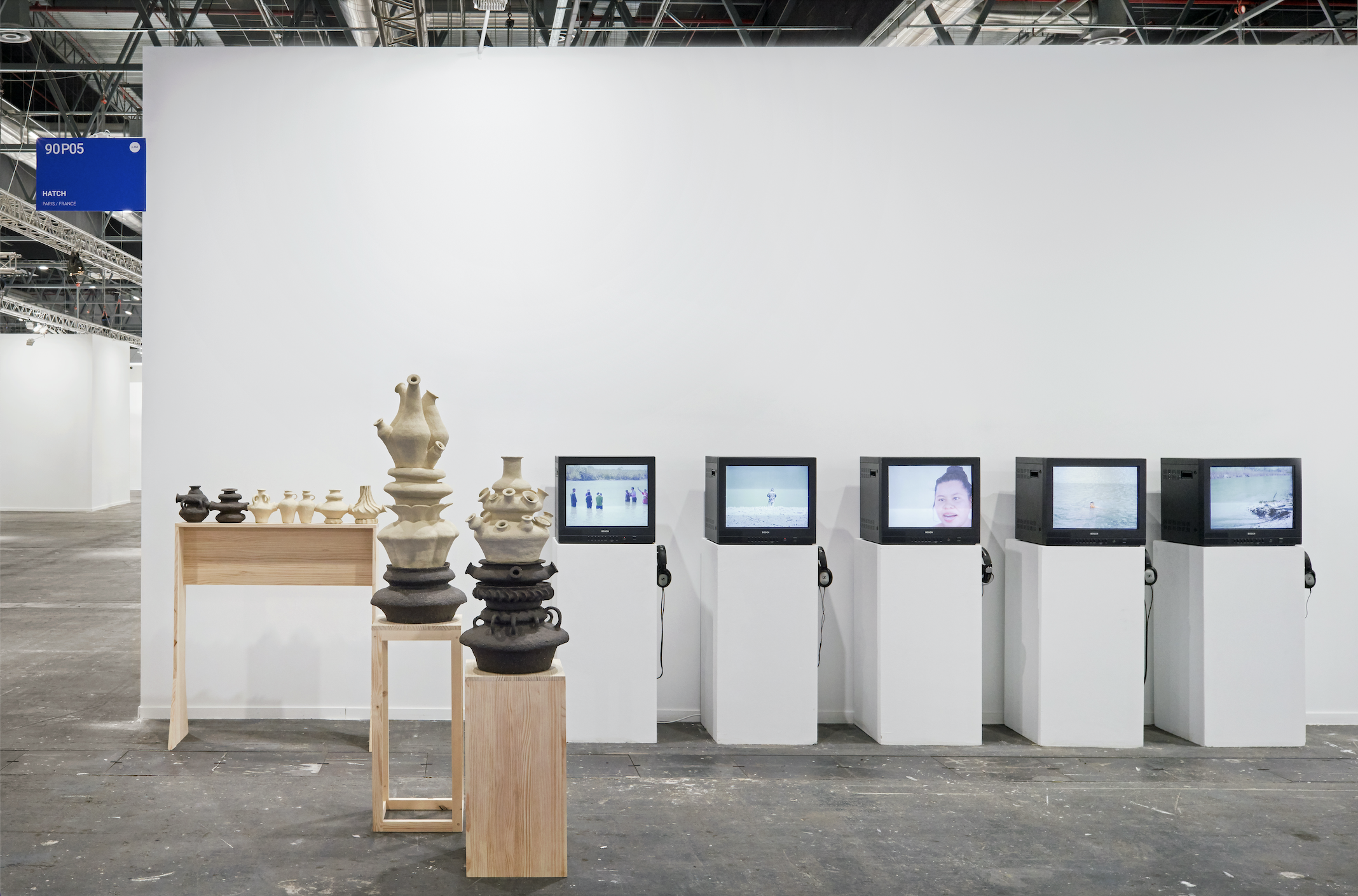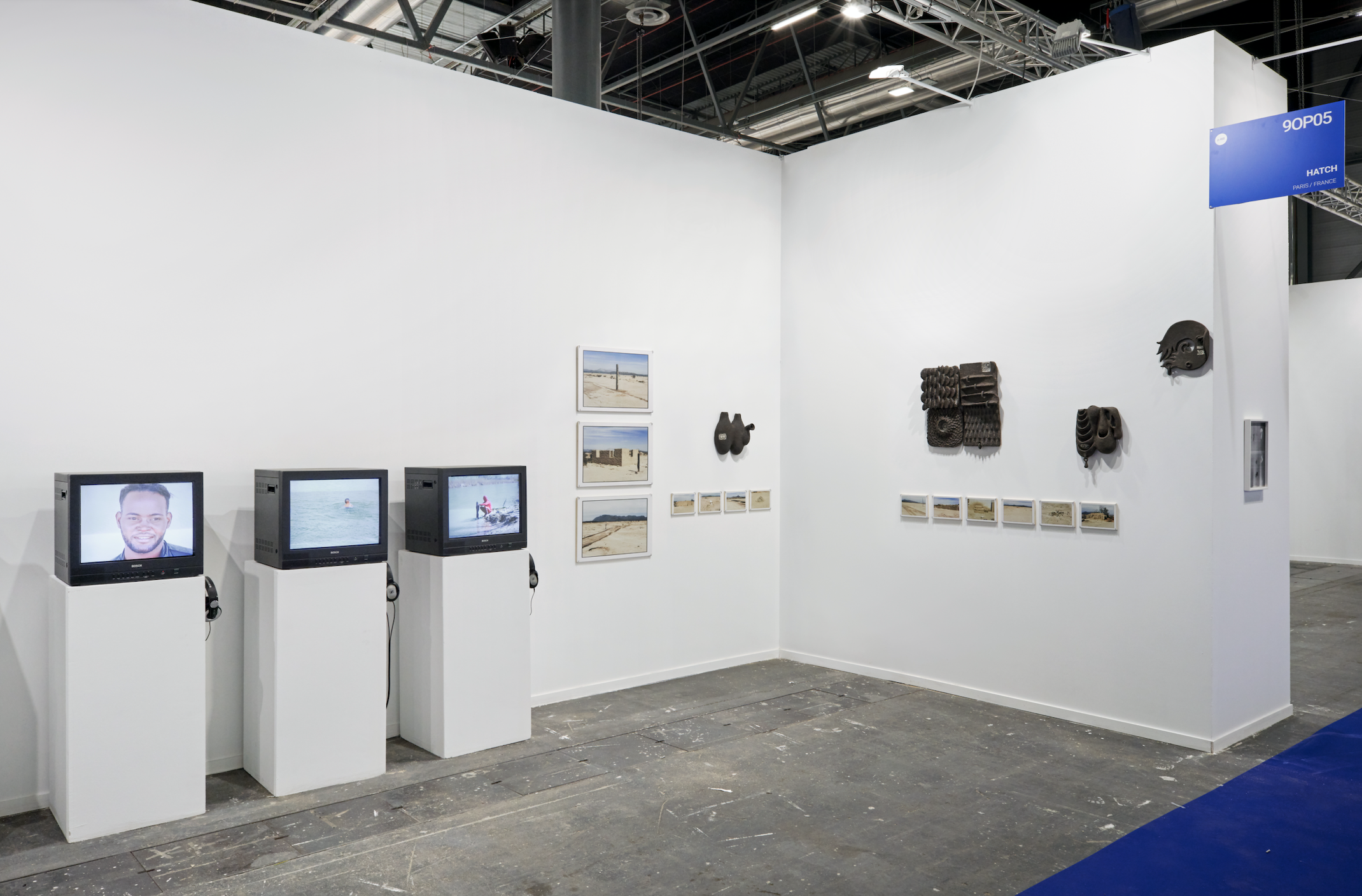Installation view from Felipe Romero Beltrán and Ayla Tavares duo presentation at ARCOmadrid with HATCH, 2024, Madrid. Photo: Choreo. Courtesy of the artists and Hatch Gallery.
Installation view from Felipe Romero Beltrán and Ayla Tavares duo presentation at ARCOmadrid with HATCH, 2024, Madrid. Photo: Choreo. Courtesy of the artists and Hatch Gallery.
ARCO Madrid
Felipe Romero Beltrán & Ayla Tavares
Opening Section - Booth 90P05
March 8 - 12, 2024
IFEMA Madrid - Av. del Partenón, 5, Barajas, 28042 Madrid, Spain
Curated by Simone Coscarelli Parma
Press:
Prize:
Migration has been a fundamental and lasting element of human history, significantly influencing cultures and economies. The contemporary world is constructed upon the narratives of migrants who, whether by choice or coercion, have traversed both physical and conceptual borders throughout the ages.
The collaborative exhibition presented by the gallery HATCH at ARCOmadrid Opening section unveils a compelling dialogue between artists Felipe Romero Beltrán and Ayla Tavares. Through their exploration of distinctly diverse materials - Beltrán’s focus on video and photography, contrasting with Tavares' work in ceramics - the artists deconstruct the conventional narrative surrounding the intricate and complex theme of migration. As the viewer is transported across geographies and artistic mediums, a contemplation arises regarding the unpredictable nature of transitional states, both in the physical body and material substances. This prompts reflection on the concepts of identity and the dissolution of boundaries.
Felipe Romero Beltrán explores the immigration journey along the Mexican border through different perspectives. The five-channel video El Cruce (2024) focuses on everyday occurrences around the Rio Bravo (Rio Grande) and sheds light on the river's distinct dual role as both a natural watercourse and a political border, serving as a dividing line between two countries. Through an exploration of migration, diaspora, and memory, the artist seamlessly intertwines his family narrative with a broader examination of global migration, consistently investigating the concept of borders, their ambiguity, and diverse manifestations.
This investigation extends into the photographic series titled La Amistad (2022-2024), where Beltrán addresses the autonomous nature of Rio Bravo and its connection to the migratory journey. In the past, the river adhered to its own natural patterns of flooding and drought, influenced by precipitation and seasonal variations. However, the construction of numerous dams and diversions along its course has now regulated these natural cycles. This human intervention has metamorphosed the river into a self-governing entity, emancipated from nature yet still overseen by man. The artist consolidates his survey with the work Arrangements (2022-2024), a series of subjective photographs of objects that either facilitate or obstruct the migrants' journey, giving the viewer an insight into the obstacles confronted by those undertaking the crossing.
Ayla Tavares offers a unique perspective on the concepts of borders and migration in her works. Archaeologists regard ceramics as a timeless medium, often serving as the sole record of a society's history, ancestry, and migratory patterns. This concept is embraced by Tavares who also considers ceramics a living medium, as it engages in a continuous exchange with its surrounding environment, creating a synergy between body and artwork that blurs the boundaries between them. Sonantes (2018-2024) comprises a series of ceramic sculptures varying in dimensions and forms, as well as in textures and colors. These pieces reach beyond their materiality and forms to evoke a shared essence: the flow within the emptiness of their bodies and the interconnected nature of their interior-receptacle. The viewer is invited to participate in a sensorial experience that proposes the repositioning of the hierarchy of senses, prioritizing touch and hearing over vision as a parameter for understanding the work.
The boundaries within Sonantes manifest in moments of contact, in the intermediary space, and the dissolution of the edges. A series of encounters unfolds unpredictably: one temporarily merges with another, forming singularities that relate through their differences. The artworks presented at Arco Madrid draw inspiration from historical artifacts referred to in Spanish as alfareria del agua (clay vessels designed for storing various liquids), research that Tavares started in 2022 during her artistic residency at the Collegium Museum in Arévalo, Spain.
In Matéria Matéria (2024), Tavares continues to explore the concepts of borders, permeability, and intersections. As part of the Notações series, this collection of works comprises ceramic wall pieces adorned with small frames featuring diverse relief drawings. These illustrations depict narratives and processes spanning from micro to macroscopic scales. For instance, they may portray the endocytosis process from the perspective of the cell membrane to the Kármán line—a distinct boundary situated approximately 100 km above sea level, commonly recognized as the demarcation between Earth's atmosphere and outer space.
Migration, transitional states, ambiguity... Beltrán and Tavares' works align in guiding the viewer towards a place where the interconnectedness and unity of all existence become understandable. In the solitude of one’s reflections, the significance of others is perceived, rekindling the empathy that society may have forsaken. Whether through the touch of a ceramic object or listening to the roaring sound of river waters, there arises an awareness of the necessity to stop building borders and instead work towards fostering a more compassionate and inclusive society.
Courtesy of Simone Coscarelli Parma

Felipe Romero Beltrán, El Cruce, 2022-2024, El bauzito, Five-Chanel video (color and sound), Composed of 5 channel videos. Ed. 1/3 + 2AP, '8''52. Courtesy of the artists and Hatch Gallery.

Ayla Tavares, Sonantes 10, From the series Sonantes, 2024, Ceramic, 100 x 36 x 36 cm, Unique. Photo: Diego Beyró. Courtesy of the artists and Hatch Gallery.

Ayla Tavares, Sonantes 11, From the series Sonantes, 2024, Ceramic, 78 x 40 x 40 cm, Unique. Photo: Diego Beyró. Courtesy of the artists and Hatch Gallery.

Ayla Tavares, Sonantes 12, 2024, Ceramic 20 x 15 x 100 cm, Unique. Photo: Diego Beyró. Courtesy of the artists and Hatch Gallery.

Felipe Romero Beltrán, El Cruce, 2022-2024, La voy y el otro, Five-Chanel video (color and sound), Composed of 5 channel videos. Ed. 1/3 + 2AP. Courtesy of the artists and Hatch Gallery.

Ayla Tavares, 100km above the sea, 2024, From the series Matéria Matéria, Graphite on ceramic, 50 x 6 x 50 cm, Unique. Photo: Diego Beyró. Courtesy of the artists and Hatch Gallery.

Felipe Romero Beltrán, The Arrangements, 2024, Lambda c-print, 40 x 60 cm, Ed. 1/ 3 + 2AP. Photo: Felipe Romero Beltran. Courtesy of the artists and Hatch Gallery.

Ayla Tavares, Sonantes 13, From the series Sonantes, 2024, Graphite on ceramic, 29 x 12 x 27 cm, unique. Photo: Diego Beyró. Courtesy of the artists and Hatch Gallery.

Felipe Romero Beltrán, The Arrangements, 2024, Lambda c-print, 40 x 60 cm, Ed. 1/ 3 + 2AP. Photo: Felipe Romero Beltran. Courtesy of the artists and Hatch Gallery.

Felipe Romero Beltrán, El Cruce, 2022-2024, Guadalupe, Five-Chanel video (color and sound), Composed of 5 channel videos. Ed. 1/3 + 2AP. Courtesy of the artists and Hatch Gallery.


